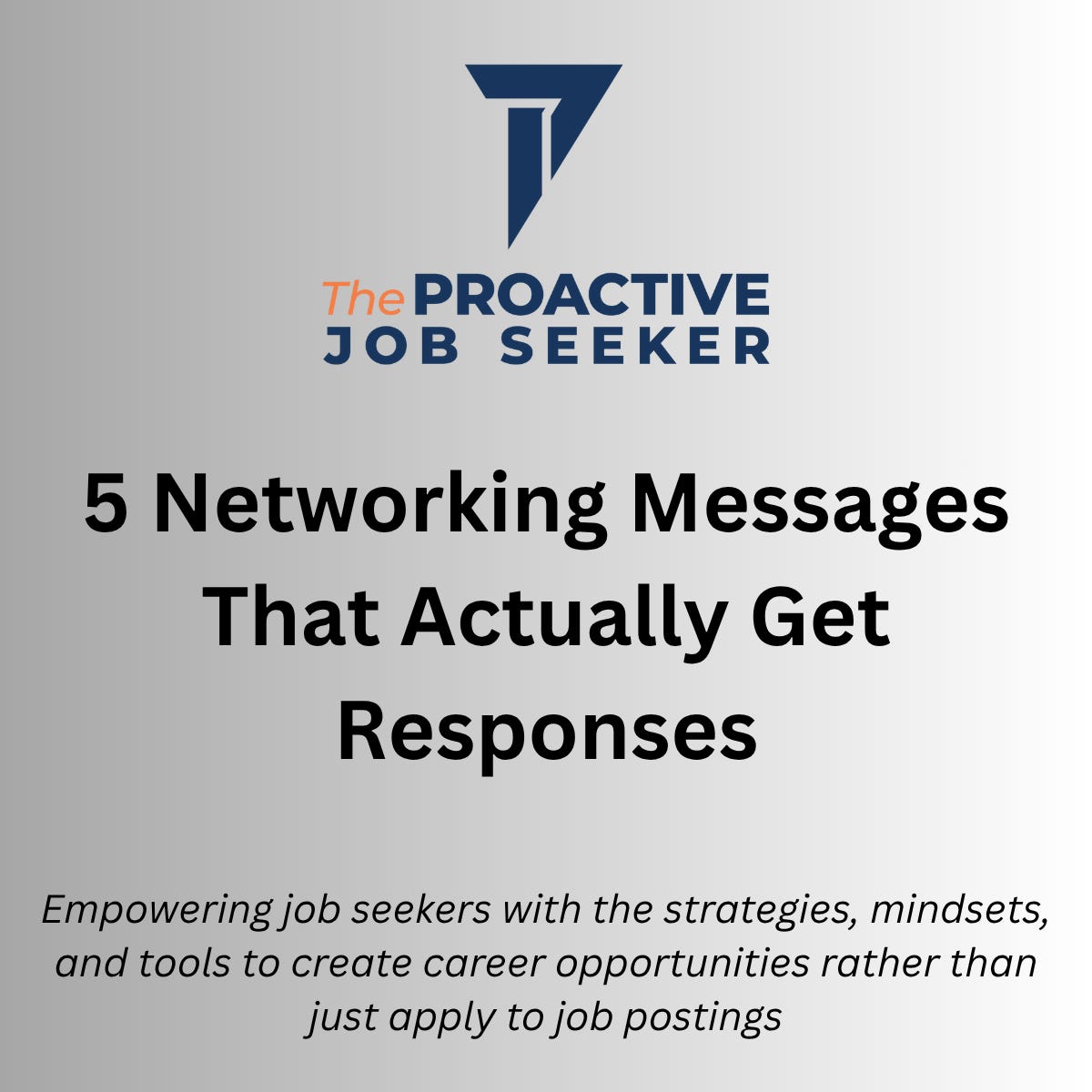5 Networking Messages That Actually Get Responses
Yesterday on LinkedIn, I shared three networking messages that work better than “I’d love to pick your brain.”
Today, I’m expanding on that with two additional message types and guidance on when to use each approach.
The Five Message Types
Message #1: The Specific Question
When to use: First contact with someone you don’t know, when you’ve identified something specific about their career path
Example: “Hi [Name], I noticed you transitioned from agency to in-house marketing 3 years ago. I’m considering the same move. Would you share what surprised you most? 15 minutes would be incredibly helpful.”
Why it works: You’re asking about their specific experience, not vague “advice.” You’ve done research. You respect their time with a clear boundary.
Message #2: The Mutual Connection
When to use: When you have a genuine mutual connection who can vouch for you or suggest you reach out
Example: “Hi [Name], [Mutual Friend] mentioned you’ve built an incredible career in product management and suggested I reach out. I’m transitioning from project to product management and would value 20 minutes of your insight on what skills matter most. Open to a brief call next week?”
Why it works: Social proof, the mutual connection reduces stranger danger and gives you credibility before you’ve said anything about yourself.
Message #3: The Value-First Approach
When to use: When you can genuinely offer something useful before asking for anything
Example: “Hi [Name], I saw your post about [specific topic]. I recently completed a project on [related topic] and thought you might find [specific insight] useful. Happy to share more. By the way, I’m exploring data analytics opportunities. If you know anyone hiring or have insights, I’d appreciate guidance.”
Why it works: You lead with value, not need. You’ve shown you’re engaged with their work. The ask becomes secondary, not transactional.
Message #4: The Alumni Connection
When to use: When you share educational background (same school, training program, bootcamp, certification)
Example: “Hi [Name], I’m a fellow [school or training organization] alum exploring opportunities in [field]. I saw you’ve built a strong career at [Company] since graduation. Would you be open to a 15-minute conversation about your path and any advice for someone coming from a similar background?”
Why it works: Shared educational experience creates instant common ground. Alumni often feel an obligation to help fellow graduates. It’s a warm(er) introduction than cold outreach.
Important: Only use this if you actually share the educational background. Never fabricate connections.
Message #5: The Industry Event Follow-Up
When to use: After attending the same webinar, conference, or virtual event (even if you didn’t speak directly)
Example: “Hi [Name], I attended [Event Name] last week and found your presentation on [topic] particularly insightful. I’m working in [related area] and would value hearing more about your approach. Would you be open to a brief follow-up conversation?”
Why it works: You have a recent, specific context for reaching out. They’re in “event mode” where networking is expected. You’re referencing something they actively shared publicly.
When to Use Which Message
Use Specific Question when: You’re cold-contacting someone and need a clear hook
Use Mutual Connection when: You have a legitimate referral or shared contact
Use Value-First when: You can genuinely offer something useful first
Use Alumni Connection when: Shared educational background exists
Use Event Follow-Up when: You’ve both attended the same recent event
What All Five Have in Common
Notice the pattern:
→ Specific, not vague - Every message has a clear, defined ask
→ Research-based - Shows you know something about them
→ Time-bounded - Respects their schedule with clear limits
→ Easy to say yes - Makes responding simple and low-risk
The messages that get ignored are the opposite:
“Let me know if you have time” (vague)
“I’d love to learn about your career” (generic)
“Can we meet for coffee?” (open-ended commitment)
“Do you know of any openings?” (asking them to do your work)
Your Action This Week
Pick ONE of these five approaches that fits your situation.
Customize the message in your own words.
Send it to THREE people.
Track who responds and what works.
That’s it. Don’t overthink it.
Want the Complete System?
These 5 messages will get you started. But if you’re serious about bypassing online applications and connecting directly with decision-makers, you need more than sample scripts.
My eBook “How to Get a Job Without Applying Online” includes:
→ 15+ networking message templates organized by situation
→ Complete follow-up sequences for when they don’t respond
→ 14-day action plan with daily tasks
→ Tracking systems to monitor your progress
→ Next-level strategies (warm introductions, content engagement, referral systems)
Get the complete guide: proactivejobseeker.gumroad.com/l/xjcorz or find it at your favorite retailer at books2read.com/u/38p6PL
See You Thursday
On Thursday, I’ll be back on LinkedIn with a post about why your resume obsession is keeping you unemployed.
In the meantime, send those three messages. Real progress happens in conversations, not in planning.
Stay proactive,
Lee Gamelin
Job Search Success Strategist
proactivejobseeker.com



